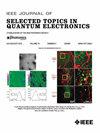三维狄拉克半金属超材料支撑太赫兹可调谐双功能偏振变换器
IF 5.1
2区 工程技术
Q1 ENGINEERING, ELECTRICAL & ELECTRONIC
IEEE Journal of Selected Topics in Quantum Electronics
Pub Date : 2025-07-24
DOI:10.1109/JSTQE.2025.3592331
引用次数: 0
摘要
目前,利用超材料动态操纵太赫兹(THz)波的偏振态在信息传输和目标探测等应用中具有重要意义。然而,将可调的多个功能集成到单个MM设备中仍然是一个关键的挑战。基于三维Dirac半金属(DSM)- teflon -石墨烯多层结构,研究了双功能偏振变换器(DPC)在太赫兹波段的传输性能,通过调节插入介质空间层的石墨烯的费米能级,可以方便地实现交叉偏振反射或透射。特别是在1.0 eV的大费米能级下,DPC实现了0.94 ~ 2.17 THz的宽带交叉极化反射,极化转换率大于0.9,通过在0.01 ~ 0.15 eV范围内调节三维DSM费米能级,交叉极化共振的最大调幅深度(MD)为29.2%。同时,当费米能级为零时,通过改变三维DSM费米能级,在1.14 THz和1.92 THz处观测到两个明显的交叉极化透射峰,对应的幅值MDs分别为49.0%和62.6%。此外,在0.01 ~ 0.15 eV范围内改变费米能级,以3D DSM薄层作为可调谐衬底,交叉极化反射曲线的最大MD幅值达到52%。这些结果有助于理解三维DSM等离子体器件的可调谐机制,并有助于设计太赫兹多功能器件,如偏振器、波片和调制器。本文章由计算机程序翻译,如有差异,请以英文原文为准。
3D Dirac Semimetal Metamaterial Supported Terahertz Tunable Dual-Functional Polarization Converter
Currently, the use of metamaterials (MMs) to dynamically manipulate the polarization state of terahertz (THz) waves is of great interest for applications such as conveying information and target detection. However, it remains a key challenge to integrate tunable and multiple functions into a single MM device. Based on a 3D Dirac semimetal (DSM)-Teflon-graphene multilayered structure, the propagation performance of the dual-functional polarization converter (DPC) has been investigated in the THz regime, which can achieve cross-polarized reflection or transmission conveniently by adjusting the Fermi level of the graphene inserted into the dielectric space layer. Particularly, at a large Fermi level of 1.0 eV, the proposed DPC realizes a broadband cross-polarized reflection at 0.94-2.17 THz with polarization conversion ratio more than 0.9, and the maximum amplitude modulation depth (MD) of the cross-polarization resonance is 29.2% by adjusting the 3D DSM Fermi level in the range of 0.01-0.15 eV. Meanwhile, if the Fermi level is zero, two obvious cross-polarized transmission peaks can be observed at 1.14 THz and 1.92 THz, and the corresponding amplitude MDs are 49.0% and 62.6% respectively, by varying the 3D DSM Fermi level. Additionally, with a thin layer of 3D DSM as a tunable substrate, the maximum MD amplitude of the cross-polarized reflection curve reaches 52% by changing the Fermi level in the range of 0.01-0.15 eV. These results are very helpful in understanding the tunable mechanisms of 3D DSM plasmonic devices and aiding the design of THz multi-functional devices, such as polarizers, wave plates, and modulators.
求助全文
通过发布文献求助,成功后即可免费获取论文全文。
去求助
来源期刊

IEEE Journal of Selected Topics in Quantum Electronics
工程技术-工程:电子与电气
CiteScore
10.60
自引率
2.00%
发文量
212
审稿时长
3 months
期刊介绍:
Papers published in the IEEE Journal of Selected Topics in Quantum Electronics fall within the broad field of science and technology of quantum electronics of a device, subsystem, or system-oriented nature. Each issue is devoted to a specific topic within this broad spectrum. Announcements of the topical areas planned for future issues, along with deadlines for receipt of manuscripts, are published in this Journal and in the IEEE Journal of Quantum Electronics. Generally, the scope of manuscripts appropriate to this Journal is the same as that for the IEEE Journal of Quantum Electronics. Manuscripts are published that report original theoretical and/or experimental research results that advance the scientific and technological base of quantum electronics devices, systems, or applications. The Journal is dedicated toward publishing research results that advance the state of the art or add to the understanding of the generation, amplification, modulation, detection, waveguiding, or propagation characteristics of coherent electromagnetic radiation having sub-millimeter and shorter wavelengths. In order to be suitable for publication in this Journal, the content of manuscripts concerned with subject-related research must have a potential impact on advancing the technological base of quantum electronic devices, systems, and/or applications. Potential authors of subject-related research have the responsibility of pointing out this potential impact. System-oriented manuscripts must be concerned with systems that perform a function previously unavailable or that outperform previously established systems that did not use quantum electronic components or concepts. Tutorial and review papers are by invitation only.
 求助内容:
求助内容: 应助结果提醒方式:
应助结果提醒方式:


